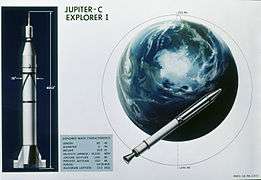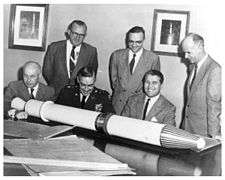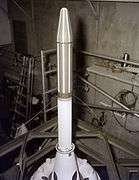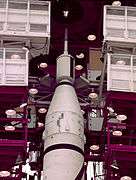Explorer 1
 Explorer 1 in its orbital configuration, with the launch vehicle's fourth stage attached | |
| Mission type | Earth science |
|---|---|
| Operator | Army Ballistic Missile Agency |
| Harvard designation | 1958 Alpha 1 |
| COSPAR ID | 1958-001A |
| SATCAT № | 00004 |
| Mission duration | 111 days |
| Spacecraft properties | |
| Manufacturer | Jet Propulsion Laboratory |
| Launch mass | 13.97 kilograms (30.8 lb) |
| Dimensions |
80.75 inches (205.1 cm) length 6.00 inches (15.2 cm) diameter |
| Power | 60 watts |
| Start of mission | |
| Launch date | February 1, 1958, 03:48 UTC[1] |
| Rocket | Juno I RS-29 |
| Launch site | Cape Canaveral LC-26A |
| End of mission | |
| Last contact | May 23, 1958 |
| Decay date | March 31, 1970 |
| Orbital parameters | |
| Reference system | Geocentric |
| Regime | MEO |
| Semi-major axis | 7,832.2 kilometers (4,866.7 mi) |
| Eccentricity | 0.140 |
| Perigee | 358 kilometers (222 mi) |
| Apogee | 2,550 kilometers (1,580 mi) |
| Inclination | 33.24° |
| Period | 114.8 minutes |
| RAAN | 334.6171 degrees |
| Argument of perigee | 311.5310 degrees |
| Mean anomaly | 48.3249 degrees |
| Mean motion | 16.275 |
| Epoch | 31 March 1970, 00:50:24 UTC |
| Revolution number | 58402 |
| Instruments | |
|
Cosmic-Ray Detector Micrometeorite Detector Satellite Drag Atmospheric Density | |
Explorer 1 was the first satellite of the United States, launched as part of its participation in the International Geophysical Year. The mission followed the first two satellites the previous year; the Soviet Union's Sputnik 1 and 2, beginning the Cold War Space Race between the two nations.
Explorer 1 was launched on January 31, 1958 at 22:48 Eastern Time (equal to February 1, 03:48 UTC) atop the first Juno booster from LC-26 at the Cape Canaveral Missile Annex, Florida. It was the first spacecraft to detect the Van Allen radiation belt,[2] returning data until its batteries were exhausted after nearly four months. It remained in orbit until 1970, and has been followed by more than 90 scientific spacecraft in the Explorer series.
Explorer 1 was given Satellite Catalog Number 4, and the Harvard designation 1958 Alpha 1,[3] the forerunner to the modern International Designator.
Background
The U.S. Earth satellite program began in 1954 as a joint U.S. Army and U.S. Navy proposal, called Project Orbiter, to put a scientific satellite into orbit during the International Geophysical Year. The proposal, using a military Redstone missile, was rejected in 1955 by the Eisenhower administration in favor of the Navy's Project Vanguard, using a booster advertised as more civilian in nature.[4][5] Following the launch of the Soviet satellite Sputnik 1 on October 4, 1957, the initial Project Orbiter program was revived as the Explorer program to catch up with the Soviet Union.[6]
Explorer 1 was designed and built by the Jet Propulsion Laboratory (JPL), while a Jupiter-C rocket was modified by the Army Ballistic Missile Agency (ABMA) to accommodate a satellite payload; the resulting rocket known as the Juno I. The Jupiter-C design used for the launch had already been flight-tested in nose cone reentry tests for the Jupiter IRBM, and was modified into Juno I. Working closely together, ABMA and JPL completed the job of modifying the Jupiter-C and building Explorer 1 in 84 days. However, before work was completed, the Soviet Union launched a second satellite, Sputnik 2, on November 3, 1957. The U.S. Navy's attempt to put the first U.S. satellite into orbit failed with the launch of the Vanguard TV3 on December 6, 1957.[7]
Spacecraft design

Explorer 1 was designed and built by the California Institute of Technology's JPL under the direction of Dr. William H. Pickering. It was the second satellite to carry a mission payload (Sputnik 2 was the first).
The total weight of the satellite was 13.37 kilograms (30.80 lb), of which 8.3 kg (18.3 lb) were instrumentation. In comparison, the first Soviet satellite Sputnik 1 weighed 83.6 kg (184 lb). The instrument section at the front end of the satellite and the empty scaled-down fourth-stage rocket casing orbited as a single unit, spinning around its long axis at 750 revolutions per minute.
Data from the scientific instruments was transmitted to the ground by two antennas. A 60 milliwatt transmitter fed a dipole antenna consisting of two fiberglass slot antennas in the body of the satellite operating on 108.03 MHz, and four flexible whips forming a turnstile antenna were fed by a 10 milliwatt transmitter operating on 108.00 MHz.[8][9]
Because of the limited space available and the requirements for low weight, the payload instrumentation was designed and built with simplicity and high reliability in mind, using transistor electronics, consisting of both germanium and silicon devices. This was a very early time frame in the development of transistor technology, and was the first documented use of transistors in the U.S. Earth satellite program.[10] A total of 29 transistors were used in Explorer 1, plus additional ones in the Army's micrometeorite amplifier. Electrical power was provided by mercury chemical batteries that made up approximately 40 percent of the payload weight.
The external skin of the instrument section was sandblasted stainless steel with white stripes. Several other color schemes had been tested, resulting in backup articles, models, and photographs showing different configurations, including alternate white and green striping and blue stripes alternating with copper. The final coloration was determined by studies of shadow–sunlight intervals based on firing time, trajectory, orbit, and inclination.
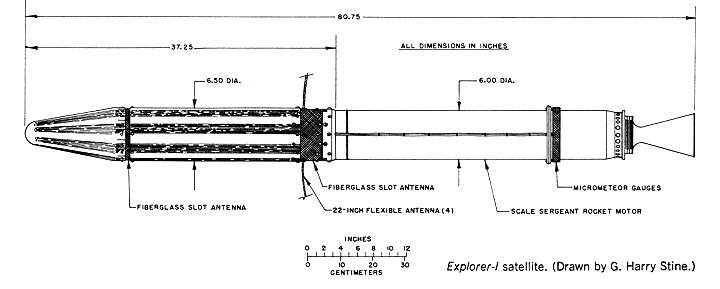
Science payload
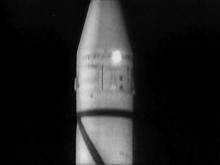
The Explorer 1 payload consisted of the Iowa Cosmic Ray Instrument without a tape data recorder which was not modified in time to make it onto the spacecraft. The real-time data received on the ground was therefore very sparse and puzzling showing normal counting rates and no counts at all. The later Explorer 3 mission, which included a tape data recorder in the payload, provided the additional data for confirmation of the earlier Explorer 1 data.
The scientific instrumentation of Explorer 1 was designed and built under the direction of Dr. James Van Allen of the University of Iowa containing:[8]
- Anton 314 omnidirectional Geiger-Müller tube, designed by Dr. George Ludwig of Iowa's Cosmic Ray Laboratory, to detect cosmic rays. It could detect protons with E > 30 MeV and electrons with E > 3 MeV. Most of the time the instrument was saturated;[11]
- Five temperature sensors (one internal, three external and one on the nose cone);
- Acoustic detector (crystal transducer and solid-state amplifier) to detect micrometeorite (cosmic dust) impacts. It responded to micrometeorite impacts on the spacecraft skin in such way that each impact would be a function of mass and velocity. Its effective area was 0.075 m2 and the average threshold sensitivity was 2.5×10−3 g cm/s;[12][13]
- Wire grid detector, also to detect micrometeorite impacts. It consisted of 12 parallel connected cards mounted in a fiberglass supporting ring. Each card was wound with two layers of enameled nickel alloy wire with a diameter of 17 µm (21 µm with the enamel insulation included) in such way that a total area of 1 cm by 1 cm was completely covered. If a micrometeorite of about 10 µm impacted, it would fracture the wire, destroy the electrical connection, and thus record the event.[12][13]
Flight
The Juno I rocket was launched January 31, 1958, putting Explorer 1 into orbit with a perigee of 358 kilometers (222 mi) and an apogee of 2,550 kilometers (1,580 mi) having a period of 114.8 minutes.[14][15][16] At about 1:30 a.m. ET, after confirming that Explorer 1 was indeed in orbit, a news conference was held in the Great Hall at the National Academy of Sciences in Washington, DC to announce it to the world.[17]
Mercury batteries powered the high-power transmitter for 31 days and the low-power transmitter for 105 days. Explorer 1 stopped transmission of data on May 23, 1958[18] when its batteries died, but remained in orbit for more than 12 years. It reentered the atmosphere over the Pacific Ocean on March 31, 1970 after more than 58,000 orbits.
Results

Explorer 1 changed rotation axis after launch. The elongated body of the spacecraft had been designed to spin about its long (least-inertia) axis but refused to do so, and instead started precessing due to energy dissipation from flexible structural elements. Later it was understood that on general grounds, the body ends up in the spin state that minimizes the kinetic rotational energy for a fixed angular momentum (this being the maximal-inertia axis). This motivated the first further development of the Eulerian theory of rigid body dynamics after nearly 200 years—to address this kind of momentum-preserving energy dissipation.[19][20]
Sometimes the instrumentation would report the expected cosmic ray count (approximately 30 counts per second) but sometimes it would show a peculiar zero counts per second. The University of Iowa (under James Van Allen) noted that all of the zero counts per second reports were from an altitude of more than 2,000 kilometres (1,200 mi) over South America, while passes at 500 km (310 mi) would show the expected level of cosmic rays. Later, after Explorer 3, it was concluded that the original Geiger counter had been overwhelmed ("saturated") by strong radiation coming from a belt of charged particles trapped in space by the Earth's magnetic field. This belt of charged particles is now known as the Van Allen radiation belt. The discovery was considered to be one of the outstanding discoveries of the International Geophysical Year.
The acoustic micrometeorite detector detected 145 impacts of cosmic dust in 78,750 seconds. This calculates to an average impact rate of 8.0×10−3 impacts m−2 s−1 over the twelve-day period (29 impacts per hour per square meter).[21]
Legacy
Explorer 1 was the first of the long-running Explorer program. A follow-up to the first mission, Explorer-1 [PRIME], was successfully launched aboard a Delta II rocket in late October, 2011. The PRIME was built using modern satellite construction techniques. The orbiting satellite was a backup, since the initial Explorer-1 PRIME, launched on March 4, 2011, failed to reach orbit due to a problem in the launch vehicle.[22]
An identically constructed flight backup of Explorer 1 is on display in the Smithsonian Institution's National Air and Space Museum, Milestones of Flight Gallery in Washington, DC.
Launch Pad 26 was deactivated in 1963, and was designated for use as a museum in 1964, the Air Force Space and Missile Museum.[23] Here too, a full-scale Explorer 1 is on display, but this one is a mockup.[24] The satellite's legacy is having been the first orbital object sent to return scientific data. Its launch happened to be 100 years to the day that the SS Great Eastern was launched. This ship was much larger than anything that came before it, and it was big enough to accomplish the task of laying out the first lasting transatlantic telegraph cable. Both events served to more closely knit the world together.
Gallery
|
See also
References
- ↑ Garber, Steve (October 10, 2007). "Explorer-I and Jupiter-C". NASA. Retrieved November 16, 2009.
- ↑ Paul Dickson, Sputnik: The Launch of the Space Race. (Toronto: MacFarlane Walter & Ross, 2001), 190.
- ↑ Yost, Charles W. (1963-09-06). Registration data for United States Space Launches (PDF). United Nations Office for Outer Space Affairs. Retrieved 2009-02-19.
- ↑ Matt Bille and Erika Lishock, The First Space Race: Launching the World's First Satellites, Texas A&M University Press, 2004, Chapter 5
- ↑ "Project Vanguard—Why It Failed to Live Up to Its Name". Time (magazine). October 21, 1957. Retrieved 2008-02-12.
- ↑ "Sputnik and the Dawn of the Space Age". NASA History. NASA. Retrieved 2008-02-13.
- ↑ McLaughlin Green, Constance; Lomask, Milton (1970). "Chapter 11: from Sputnik I to TV-3". Vanguard—A History. NASA. Retrieved 2008-02-13.
- 1 2 "Explorer-I and Jupiter-C". Data Sheet. Department of Astronautics, National Air and Space Museum, Smithsonian Institution. Retrieved 2008-02-09.
- ↑ Williams, Jr., W.E. (April 1960). "Space Telemetry Systems" (fee required). Proceedings of the Institute of Radio Engineers. IEEE. 48 (4): 685–690. doi:10.1109/JRPROC.1960.287448. Retrieved 2008-02-05.
- ↑ "The First Transistors in Space—Personal Reflections by the Designer of the Cosmic Ray Instrumentation Package for the Explorer I Satellite". A Transistor Museum Interview with Dr. George Ludwig. The Transistor Museum. Retrieved 2008-02-25.
- ↑ "Cosmic-Ray Detector". NSSDC Master Catalog. NASA. Retrieved 2008-02-09.
- 1 2 "Micrometeorite Detector". NSSDC Master Catalog. NASA. Retrieved 2008-02-09.
- 1 2 Manring, Edward R. (January 1959). "Micrometeorite Measurements from 1958 Alpha and Gamma Satellites". Planetary and Space Science. Great Britain: Pergamon Press. 1 (1): 27–31. Bibcode:1959P&SS....1...27M. doi:10.1016/0032-0633(59)90019-4.
- ↑ "Explorer 1 First U.S. Satellite—Fast Facts". JPL, NASA. Retrieved 2008-02-06.
- ↑ "Trajectory Details". NSSDC Master Catalog. NASA. Retrieved 2008-02-06.
- ↑ "Solar System Exploration Explorer 1". NASA. Retrieved 2008-02-06.
- ↑ McDonald, Naugle (2008). "Discovering Earth's Radiation Belts: Remembering Explorer 1 and 3". NASA History. American Geological Union. 89 (39). Retrieved 2008-10-14.
- ↑ Zadunaisky, Pedro E. (October 1960). "The Orbit of Satellite 456 Alpha (Explorer I) during the First 10500 Revolutions". SAO Special Report. Smithsonian Astrophysical Observatory. 50. Bibcode:1960SAOSR..50.....Z.
- ↑ Efroimsky, Michael (August 2001). "Relaxation of wobbling asteroids and comets—theoretical problems, perspectives of experimental observation" (fee required). Planetary and Space Science. Elsevier. 49 (9): 937–955. arXiv:astro-ph/9911072
 . Bibcode:2001P&SS...49..937E. doi:10.1016/S0032-0633(01)00051-4. Retrieved 2015-10-04.
. Bibcode:2001P&SS...49..937E. doi:10.1016/S0032-0633(01)00051-4. Retrieved 2015-10-04. - ↑ Efroimsky, Michael (March 2002). "Euler, Jacobi, and missions to comets and asteroids" (fee required). Advances in Space Research. Elsevier. 29 (5): 725–734. arXiv:astro-ph/0112054
 . Bibcode:2002AdSpR..29..725E. doi:10.1016/S0273-1177(02)00017-0. Retrieved 2008-02-05.
. Bibcode:2002AdSpR..29..725E. doi:10.1016/S0273-1177(02)00017-0. Retrieved 2008-02-05. - ↑ Dubin, Maurice (January 1960). "IGY Micrometeorite Measurements" (fee required). Space Research—Proceedings of the First International Space Science Symposium. Amsterdam: North-Holland Publishing Company. 1 (1): 1042–1058. Retrieved 2008-02-11.
- ↑ Evelyn Boswell (23 October 2011). "MSU's twin satellite to launch Oct. 28 on NASA rocket". Space Science and Engineering Laboratory. Retrieved 1 October 2013.
- ↑ Launch Complex 26 Blockhouse
- ↑ Explorer I
- ↑ Nemiroff, R.; Bonnell, J., eds. (2008-01-31). "The First Explorer". Astronomy Picture of the Day. NASA. Retrieved 2008-02-03.
- ↑ "NASA—JPL Ground Antenna". Nasa.gov. Retrieved 2012-03-30.
External links
| Wikimedia Commons has media related to Explorer 1. |
- Explorer 1 Mission Profile on NASA's Solar System Exploration site
- NASA's 50th Anniversary of the Space Age including Explorer 1 - Interactive Media
- newsreel footage of the Explorer 1 launch
- Data Sheet, Department of Astronautics, National Air and Space Museum, Smithsonian Institution
- A film clip "Army Explorers in Space (1958)" is available at the Internet Archive
- A film clip "Atlas In Orbit. Radios Ike's Message Of Peace To World, 1958/12/22 (1958)" is available at the Internet Archive
- The short film Big Picture: Army Satellites is available for free download at the Internet Archive
- Lecture with detailed evaluation of the Explorer 1 rotation anomaly
